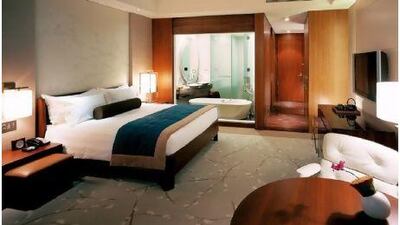The welcome
A massive painting by the artist Toko Shinoda is the first thing to greet you as you step out of the lift into the hotel lobby. In sumi-e, a traditional form of ink painting, the effect is both ultra-modern and distinctly Japanese, like the rest of the hotel. As with most of Tokyo's newer establishments, the Conrad Tokyo shares space in a high-rise block, and is located on the 28th to the 37th floors of the Shiodome Tokyo building. Modern Japanese art is everywhere. Combined with the lighting and dark, earthy colours of the decor, the overall effect is of a small boutique hotel, not of a major chain. The service is decidedly less traditional - the staff do not bow as deeply or as often as at other local hotels, perhaps a result of the Hilton brand's American roots.
The neighbourhood
This is one of the Conrad's best assets. It is a five-minute walk from Ginza shopping district, which boasts almost every major international and domestic designer label and some of the city's best eateries, a 10-minute walk from the famous Tsukiji fish market, the best location for sushi fresh off the boat, and a very short train ride from the Asakusa, the heart of ancient Tokyo. Shiodome itself, though, is somewhat nondescript: filled with the headquarters of telecommunications and media companies and thestreets crammed with suits headed to and from work. Shiodome station is not the most convenient metro stop; getting to popular destinations requires several line changes. However, Shinbashi station, a major metro and rail hub, is a two-minute walk.
The room
In keeping with the design of the rest of the hotel, our room is a tribute to Japanese minimalism. The hotel's designers play on constant themes in Japanese artwork: sumi-e, cherry blossom and mon(gate symbol). Above the headboard is a nature scene that is continued in the pattern of the carpets. As you enter, the first thing you notice is the plant, or rather, the twig, on a pedestal - a modern take on bonsai. Our bay view room overlooks Tokyo Bay and the Hamarikyu garden with the famous rainbow bridge to Odaiba in the distance. The bathroom is spacious with his-and-hers sinks. The bed is firm and comfortable, perfect after a long day of seeing the sights.
The service
While the rest of the hotel's take on modern Japan is delightful, the service could have been more traditional. The staff was more than friendly, but requests for information about the neighbourhood were met with the half-hearted provision of a map and vague finger pointing in the general direction of our destination. Check-in involved a long period of waiting on a bench while my information was found. The staff at the hotel's Gordon Ramsay restaurant, however, were knowledgable and efficient, present when you needed them and invisible otherwise.
The food
The hotel is home to not one but two Michelin-starred restaurants. We tried Gordon Ramsay's eponymous restaurant, and the tasting menu my partner and I enjoyed began with foie gras and sweetbreads topped with espresso syrup and almond foam - a bizarre combination of flavours and ingredients, but delightful. More familiar was the pasta course of lobster tortellini in a bisque and chervil velouté. The star of the show was the fillet of beef accompanied by slow-braised shank and pommes fondantwith bone marrow. Typical set menus cost around ¥13,316 (Dh600) per person.
The hotel's other restaurant, China Blue, offers Chinese food with a modern twist and is rated one of the best restaurants in town. Set menus run from around ¥4,438 (Dh200) per person for dim sum to ¥19,973 (Dh900) per person for sumptuous feasts. If you want Japanese food, Kazahana offers kaiseki, sukiyaki and teppanyaki, but it is nothing special - in a country where great Japanese food is everywhere, there is little point in paying ¥6,658 (Dh300) and upwards, when you could find better and cheaper options on the street.
The scene
Even though it's been open five years, the 290-room hotel has not gone out of style and is still strikingly beautiful: the lobby is cavernous, with towering windows overlooking Tokyo. Like a Zen garden, the decor is neutral, except for the various art works from 23 of Japan's best-known artists. The lack of other decor means that these fantastic pieces have the maximum possible effect. Although the hotel does not stand out from the other office blocks in Tokyo's busy business districts, inside it's a trendy hotel, drawing both the business crowd and foreign tourists.
Loved
The design of the hotel. The Mizuka spa treatment rooms contain beautiful hinoki (cypress) baths for relaxing. Here you can get the onsen experience in a private setting, which, for those not used to bathing in a public setting, can be preferable to the more traditional approach to hot springs.
Hated
Having to pay for internet access. Paying ¥1,500 (Dh67) for a day's worth of Wi-Fi is pennypinching.
The verdict
This is not considered to be the best luxury hotel in Tokyo, but it is among the most beautiful. If you are in Tokyo to see the sights, it would be difficult to beat the Conrad for its combination of price, luxurious amenities and location.
The bottom line
Rooms with a view of Tokyo Bay start at ¥42,000 (Dh 1,755), including taxes. Add ¥2,500 (Dh112) for breakfast. The Conrad Tokyo (www.hilton.com; 00 81 3 6388 8000).

